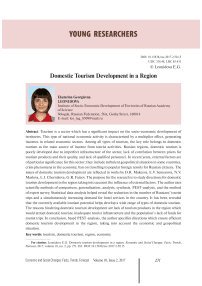Domestic tourism development in a region
Автор: Leonidova Ekaterina Georgievna
Журнал: Economic and Social Changes: Facts, Trends, Forecast @volnc-esc-en
Рубрика: Young researchers
Статья в выпуске: 2 (50) т.10, 2017 года.
Бесплатный доступ
Tourism is a sector which has a significant impact on the socio-economic development of territories. This type of national economic activity is characterized by a multiplier effect, generating incomes in related economic sectors. Among all types of tourism, the key role belongs to domestic tourism as the main source of income from tourist activities. Russian regions, domestic tourism is poorly developed due to imperfect infrastructure of the sector, lack of correlation between prices for tourism products and their quality, and lack of qualified personnel. In recent years, external factors are of particular significance for this sector; they include turbulent geopolitical situation in some countries, crisis phenomena in the economy, ban on travelling to popular foreign resorts for Russian citizens. The issues of domestic tourism development are reflected in works by D.R. Makeeva, E.V. Semenova, N.V. Maslova, L.I. Chernikova, G.R. Faizov. The purpose for the research is to study directions for domestic tourism development in the region taking into account the influence of external factors...
Tourism, domestic tourism, region, economy
Короткий адрес: https://sciup.org/147223929
IDR: 147223929 | УДК: 338.48 | DOI: 10.15838/esc.2017.2.50.15
Текст научной статьи Domestic tourism development in a region
Introduction. Russian regions, the economy of which is dominated by single industry, face an urgent task of searching for internal sources of development. Of particular relevance to the territory is the development of industries that have a multiplicative effect, i.e. a positive effect on related sectors of the economy, creating new jobs, increasing mobility of the population, as well as making more contribution to the budgets of all levels, providing economic growth of the territory. Tourism can be considered as a sector having similar characteristics. According to the World Tourism Organization, this area accounts for 9.8% of world gross domestic product and every 11th workplace [18; 20]. The tourism industry induces the development of up to 32 contiguous sectors of the economy. In addition, it helps diversify the economy while improving the sustainability of socioeconomic systems. It should be noted that the development of this industry does not exclude the traditional way of development of the productive sector of the economy (mechanical engineering, manufacturing, oil and gas sector, etc.), and promotes more efficient use of existing capacity in the region, in particular, tourism resources.
In 2014–2016 the structure of tourist market of the Russian Federation went through major changes associated with the reduction in outbound tourist flow due to a significant depreciation of the national currency, the impact of the economic crisis, long-term ban on the sale of tours for Russians in the leading outbound destinations (Turkey and Egypt) and also due to the turbulent geopolitical situation in the world. This led to the reduction in the demand of Russians for foreign destinations and increased interest in spending holidays within the country.
In the Russian Federation, domestic tourism that involves the movement of citizens within the country for tourism purposes, is not developed fully. Meanwhile, in the economies of foreign countries (USA, China, Japan, etc.) it provides up to 80% of cash income broken down by types of tourism (Fig. 1) .
Thus, the relevance of this research is due to the contradiction between high socioeconomic importance of domestic tourism and the low level of its development in the regions of Russia under modern economic conditions. The aim of the research is to find scientific substantiation for the efforts that will promote the development of domestic tourism in the region taking into account the influence of external factors. To achieve the goal, the author reviewed existing approaches to the concept of “domestic tourism”, analyzed the development of this sphere in Russian regions and determined the influence of external factors on it.
Research methods. Methodological approaches to the research are based on scientific methods such as comparison, generalization, analysis, synthesis, PESTanalysis and expert survey. The information base of the research contains the works of domestic and foreign economists in the
Figure 1. Tourism expenditures of residents and international tourists in 2015, billion US dollars [17; 20]
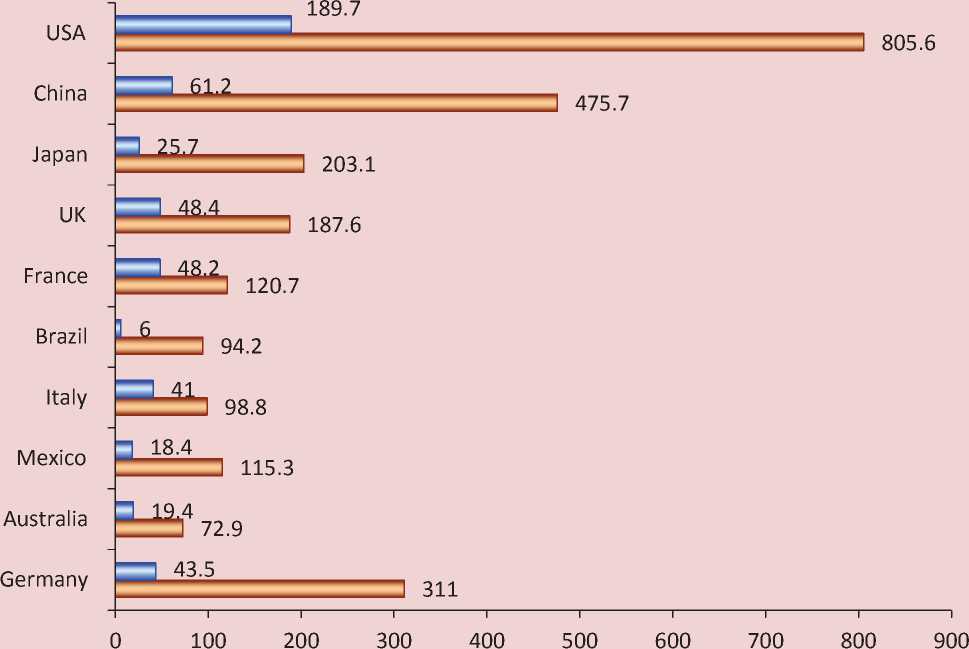
□ Outbound tourism □ Domestic tourism
field of methodological and practical issues of managing tourism development, taking into account regional specifics. The issues of regional development are highlighted in the works of the following scientists: A.G. Granberg, S.Yu. Glazyev, R.S. Grinberg and others [2; 10; 12]. Theoretical and practical approaches to tourism development are widely discussed in the works of foreign scientists, who with regard to domestic tourism consider the importance of its development for the economy of the territory and focusing on its problems [19; 21]. The impact of tourism on the economy at the regional level is studied by domestic scientists T.N. Grigorenko, L.N. Kaz’mina, V.I. Kruzhalin, K.V. Kruzha-lin, N.V. Shabalina, T.V. Uskova and others [1; 3; 6; 11; 13-15; 19; 21]. Domestic tourism development was studied by D.R. Makeeva, E.V. Semenova, N.V. Maslova, L.I. Chernikova, G.R. Faizova and other scientists [7; 9; 6]. The analysis of the above mentioned works allows the author to conclude that the ways of stimulating domestic tourism development at the regional level have not been studied sufficiently. Furthermore, they do not show the correlation between domestic tourism and regional development clearly.
,xxxdlar'9esx:?
Research findings . Despite the wide use of the term “domestic tourism”, it still has no universally accepted definition that takes into account and includes all of its features. According to federal law “About the bases of tourism in the Russian Federation” No. 132 dated November 24, 1996, domestic tourism is defined as the tourism within the territory of the Russian Federation that concerns persons who are permanent residents of the Russian Federation. V.A. Kvartal’nov offers to understand domestic tourism as temporary departure of citizens of the country with their permanent residence within the national borders of the same country for vacation, satisfaction of cognitive interests, sports and other tourism purposes [4].
These definitions specify the subjects of domestic tourism and their purpose and emphasize its territorial aspect; however, they do not take into account its economic and social impact on the territories development. Although it is known that domestic tourism is more important for the economy of the region than inbound and outbound tourism, since production and consumption of tourist product in the region encourages local producers to expand production of goods and services and promotes the growth of final consumption, thereby increasing the volume of gross regional product. In addition to creating new jobs and satisfying the needs of the population in recreation, knowledge, etc., the social function of domestic tourism is to develop human potential in the region.
Thus, the tourism infrastructure, including a network of accommodation, catering, entertainment, recreation and sports, helps to relieve mental and emotional tension, improve the health of residents of both the region and the country as a whole.
In order to ensure socio-economic development in the regions characterized by a decrease in macroeconomic indicators, it is necessary to search for and substantiate the internal sources of economic growth. In view of the above, it should be noted that domestic tourism can be considered as a driver of economic growth, because on the basis of existing resources it produces the tourist product, the consumption of which by tourists helps develop the region’s economy. The approach considered here does not contradict the existing areas of research on domestic tourism and provides an opportunity to complement the essence of the phenomenon, reflecting its role in the socio-economic development of the region.
Analysis of statistical information suggests that the new economic conditions led to lower demand for tours to foreign countries among Russian tourists. Thus, the total number of outbound tourist trips in 2015 compared to 2014 has decreased by almost 20% (Tab. 1) .
For the period from 2010 to 2015 there has been an increase in the number of Russians staying in hotels and other accommodation facilities (boarding houses, camps, campsites, etc.) in all federal districts of the Russian Federation (Tab. 2) .
Table 1. Countries with the highest number of arrivals of Russian tourists
|
Country |
Number of trips, thousand |
Dynamics |
Ranking according to the number of trips |
||
|
2014 |
2015 |
% |
2014 |
2015 |
|
|
Finland |
4 283 |
3 067 |
-28.4 |
1 |
4 |
|
Turkey |
4 216 |
3 460 |
-17.9 |
2 |
2 |
|
Kazakhstan |
3 330 |
3 125 |
-6.2 |
3 |
3 |
|
Abkhazia |
3 282 |
3 824 |
16.5 |
4 |
1 |
|
Egypt |
2 880 |
2 244 |
-22.1 |
5 |
5 |
|
Ukraine |
2 558 |
1 657 |
-35.2 |
6 |
6 |
|
Estonia |
1 775 |
1 477 |
-16.8 |
7 |
7 |
|
China |
1 731 |
1 284 |
-25.8 |
8 |
9 |
|
Poland |
1 608 |
1 322 |
-17.8 |
9 |
8 |
|
Germany |
1 435 |
1 111 |
-22.6 |
10 |
10 |
|
Thailand |
1 250 |
675 |
-46.0 |
11 |
13 |
|
Greece |
1 165 |
634 |
-45.6 |
12 |
16 |
|
Spain |
1 140 |
693 |
-39.2 |
13 |
12 |
|
Italy |
994 |
662 |
-33.4 |
14 |
14 |
|
Lithuania |
798 |
743 |
-6.9 |
15 |
11 |
|
UAE |
737 |
472 |
-35.9 |
16 |
19 |
|
Azerbaijan |
734 |
584 |
-20.4 |
17 |
17 |
|
Cyprus |
670 |
550 |
-17.9 |
18 |
18 |
|
Bulgaria |
559 |
413 |
-26.1 |
19 |
20 |
|
Georgia |
532 |
651 |
22.3 |
20 |
15 |
|
France |
521 |
408 |
-21.7 |
21 |
21 |
|
Czech Republic |
513 |
361 |
-29.7 |
22 |
22 |
|
Latvia |
404 |
312 |
-22.8 |
23 |
24 |
|
Israel |
361 |
299 |
-17.2 |
24 |
25 |
|
South Ossetia |
358 |
Less than 321 |
Less than -10.3 |
25 |
Less than 25 |
|
Vietnam |
352 |
321 |
-8.8 |
26 |
23 |
|
Other countries |
5 088 |
4 041 |
-20.6 |
Х |
Х |
Source: Ovcharova L.N. (Ed .). Naselenie Rossii v 2016 godu: dokhody, raskhody i sotsial’noe samochuvstvie. Monitoring NIU VShE. Iyul’ 2016 [Russia’s population in 2016: incomes, expenditures, and social well-being. HSE monitoring. July 2016]. Moscow: NIU VShE, 2016.
Table 2. Number of Russian staying in collective accommodation facilities, thousand people
|
Territory |
2010 |
2011 |
2012 |
2013 |
2014 |
2015 |
2015 to 2010, % |
|
Russian Federation |
27166.7 |
29310.2 |
31798.4 |
32560.6 |
33798.5 |
43656.9 |
161 |
|
Central Federal District |
7759.5 |
8303.2 |
9029.3 |
9418.3 |
9660.9 |
11921.4 |
154 |
|
Southern Federal District |
3434.2 |
3472.3 |
3651.4 |
3681.5 |
4809.4 |
6846.8 |
199 |
|
Volga Federal District |
4460.2 |
4914.2 |
5635.0 |
5850.9 |
5707.1 |
6777.1 |
152 |
|
Northwestern Federal District |
3546.0 |
3936.0 |
4051.2 |
4051.9 |
4209.1 |
5415.1 |
153 |
|
Siberian Federal District |
3138.8 |
3402.1 |
3608.7 |
3867.3 |
3519.8 |
4485.0 |
143 |
|
Ural Federal District |
2201.0 |
2543.7 |
2987.6 |
2979.2 |
2784.4 |
3054.6 |
139 |
|
Far Eastern Federal District |
1607.9 |
1698.0 |
1760.9 |
1609.0 |
1518.9 |
2028.6 |
126 |
|
Crimean Federal District |
- |
- |
- |
- |
442.1 |
1825.1 |
413 |
|
North Caucasian Federal District |
1019.2 |
1040.6 |
1074.4 |
1102.5 |
1146.7 |
1303.2 |
128 |
|
Source: Federal State Statistics Service. |
|||||||
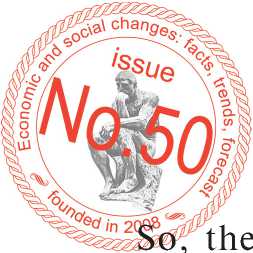
, : value of this indicator in the Southern Federal District increased almost twice due to the growth of the exchange rate of the national currency and the closure of major recreation destinations – Turkey and Egypt. It should be noted that in 2014–2015, thanks to the accession of the Republic of Crimea to the Russian Federation, the number of guests in accommodation facilities increased fourfold. These data show the growing demand of Russian citizens for hotel services, which, among other things, is due to the interest in domestic tourism resources.
According to experts of the Higher School of Economics, cheaper travel within the country and the transition to saving strategies can be a growth factor in the market of domestic tourism [8].
One of the regions most favorable for the development of tourism and attracting domestic tourists is the Northwestern Federal
District (NWFD) that concentrates cultural, historical and natural resources that serve as the basis for the creation of diverse tourism products. It has the largest number of monuments of culture and nature protected by UNESCO (Tab. 3) .
In addition, as of 2014, the federal district ranks second in Russia after the Central Federal District by number of cultural heritage objects. Tourism resources of the Northwestern Federal District are important in developing cultural, historical, environmental, event, rural, and other types of tourism, which attracts domestic tourists as well.
However, the currently available potential is not efficient. Thus, the analysis of sales of the tours shows that in 2010 and 2015 the proportion of tours sold by travel agencies of the NWFD in the regions of the Russian Federation is not high (Tab. 4) . For example, in 2015 the value of this index amounted to 32% of the total volume of tours.
Table 3. UNESCO list of world cultural heritage sites located in the Northwestern Federal District
Site Location Year of inclusion in the list Number of the site in the list Historic center of Saint Petersburg and related groups of monuments Saint Petersburg 1990 540 Architectural ensemble of the Kizhi Pogost Republic of Karelia 1990 544 Historic monuments of Novgorod and surroundings Novgorod Oblast 1992 604 Cultural and Historic Ensemble of the Solovetsky Islands Arkhangelsk Oblast 1992 632 Virgin Komi forests Republic of Komi 1995 719 Ensemble of the Ferapontov monastery Vologda Oblast 2000 982 Curonian Spit Kaliningrad Oblast (together with Lithuania) 2003 994 Struve Geodetic Arc Leningrad Obast 2005 1187 Source: Official website of UNESCO. Available at: (accessed 01.08.2016).
Table 4. Number of tours sold by travel agencies of the NWFD, thousand units
|
Number of tours |
2010 |
2011 |
2012 |
2013 |
2014 |
2015 |
2015 to 2010, % |
|
Total |
545.4 |
626.4 |
790.3 |
1029.1 |
496.6 |
156.2 |
28.6 |
|
Including tours within Russia |
115.2 |
89.8 |
141.3 |
143.4 |
147.0 |
49.5 |
43.0 |
|
Tours to other countries |
383.8 |
468.2 |
616.1 |
834.0 |
284.8 |
102.8 |
26.8 |
|
Source: Federal State Statistics Service. |
|||||||
Table 5. Number of collective accommodation facilities in the NWFD, units
|
Territory |
2010 |
2011 |
2012 |
2013 |
2014 |
2015 |
2015 to 2010, % |
|
Northwestern Federal District |
1454 |
1532 |
1893 |
1504 |
1556 |
1942 |
133.6 |
|
Saint Petersburg |
360 |
382 |
434 |
382 |
389 |
412 |
114.4 |
|
Leningrad Oblast |
265 |
322 |
393 |
253 |
269 |
274 |
103.4 |
|
Kaliningrad Oblast |
57 |
57 |
81 |
109 |
109 |
201 |
352.6 |
|
Vologda Oblast |
145 |
142 |
171 |
131 |
120 |
200 |
137.9 |
|
Republic of Karelia |
105 |
125 |
149 |
129 |
133 |
182 |
173.3 |
|
Arkhangelsk Oblast |
124 |
120 |
142 |
112 |
145 |
166 |
133.9 |
|
Murmansk Oblast |
136 |
127 |
183 |
118 |
119 |
143 |
105.1 |
|
Republic of Komi |
97 |
76 |
97 |
86 |
87 |
132 |
136.1 |
|
Novgorod Oblast |
92 |
97 |
135 |
110 |
111 |
126 |
137.0 |
|
Pskov Oblast |
73 |
84 |
108 |
74 |
74 |
106 |
145.2 |
|
Sources: Rossiiskii statisticheskii ezhegodnik: stat. sb. [Russian statistics yearbook: statistics collection]. Moscow: Rosstat, 2015. 728 p.; Kul’tura, turizm i otdykh v Pskovskoi oblasti. 2015: stat. sb. [Culture, tourism and recreation in the Pskov Oblast: statistics collection]. Pskov, 2015. P. 34. |
|||||||
The number of collective accommodation facilities (CAF) in this region is increasing. Between 2010 and 2015, it grew by nearly 34% (Tab. 5) . The growth of this indicator was observed in all constituent entities of the Northwestern Federal district: in the Kaliningrad Oblast alone – in 3.5 times. This trend is due to the interest on the part of representatives of hotel business in the construction of new facilities.
At the same time, as shown by the analysis of utilization rate of CAF, their occupancy rate in the Northwestern Federal District is quite low – 0.36 (Tab. 6). At that, during the analyzed period, the value of this indicator in the Arkhangelsk, Pskov, Leningrad and Murmansk oblasts and in the Komi Republic decreased.
This can be explained by the fact that the hotel market is characterized by high competition from the entities providing accommodation services, and a lack of tourist product capable to satisfy consumers and, thus, attract the tourist to stay at the hotel or similar accommodation facility. In the majority of NWFD subjects tourism companies offer similar tours that are based only on sightseeing.
Table 6. Utilization rate of hotels and similar accommodation facilities in the NWFD
|
Territory |
2010 |
2012 |
2013 |
2014 |
2015 |
2015 to 2010, % |
|
Saint Petersburg |
0.39 |
0.44 |
0.37 |
0.35 |
0.49 |
125.6 |
|
Northwestern Federal District |
0.33 |
0.36 |
0.33 |
0.30 |
0.36 |
109.1 |
|
Novgorod Oblast |
0.33 |
0.30 |
0.28 |
0.28 |
0.33 |
100.0 |
|
Arkhangelsk Oblast |
0.43 |
0.37 |
0.25 |
0.33 |
0.33 |
76.7 |
|
Kaliningrad Oblast |
0.15 |
0.34 |
0.33 |
0.20 |
0.32 |
213.3 |
|
Republic of Karelia |
0.29 |
0.29 |
0.29 |
0.27 |
0.30 |
103.4 |
|
Republic of Komi |
0.31 |
0.38 |
0.41 |
0.33 |
0.30 |
96.8 |
|
Pskov Oblast |
0.32 |
0.32 |
0.27 |
0.19 |
0.26 |
81.3 |
|
Leningrad Oblast |
0.27 |
0.29 |
0.28 |
0.20 |
0.25 |
92.6 |
|
Murmansk Oblast |
0.28 |
0.26 |
0.32 |
0.25 |
0.25 |
89.3 |
|
Vologda Oblast |
0.16 |
0.18 |
0.23 |
0.22 |
0.23 |
143.8 |
|
Source: Kul’tura, turizm i otdykh v Pskovskoi oblasti. 2015: stat. sb. [Culture, tourism and recreation in the Pskov Oblast: statistics collection]. Pskov, 2015. P. 36. |
||||||
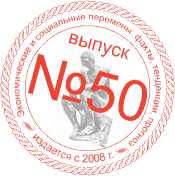
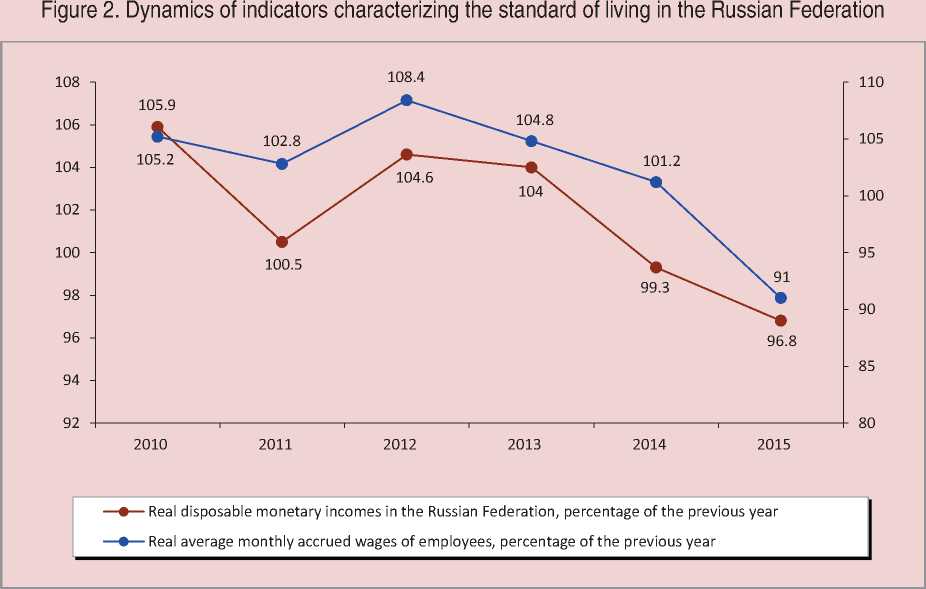
Source: Federal State Statistics Service of the Russian Federation. Available trud/sr-zarplata/;
In addition, the growing demand of the population of the Russian Federation for the services of accommodation facilities is hampered by the reduction in people’s real income and wages. During 2012–2015 these indices showed a declining trend (Fig. 2) .
Another problem of tourism development in the region is the fact that the infrastructure does not comply with world standards of quality and service. For example, only half of roads (53.3%) in the NWFD have high quality surfacing (Tab. 7) . This fact reduces the accessibility of domestic tourists to the region’s sights.
In many constituent entities of the Russian Federation there is no system of classification of hotels, beaches, ski facilities and other tourist facilities, that affects the quality of services provided. Meanwhile, the classifi- cation of hotel enterprises is one of t important mechanisms in managing the quality of services, as it gives an opportunity to estimate objectively the level of services and confirm their safety for consumers [5].
Thus, the development of domestic tourism in the Russian Federation in general and in the Northwestern Federal District in particular has its problems. Among all the subjects of the Northwestern Federal District, the Vologda Oblast is characterized by high cultural and historical potential, which provides favorable conditions for the development of a wide range of tourism activities.
The analysis of the impact of external factors on the development of this sector of the tourist market was carried out with the use of PEST analysis, which was based on the
Table 7. Some indicators of the quality of roads for 2015
Territory Total length of roads, km Proportion of public roads with improved surface* to the total length of public hard-surface roads, % Northwestern Federal District 142 080.9 53.3 Saint Petersburg 3 412.1 92.5 Murmansk Oblast 3 523.4 77.8 Kaliningrad Oblast 8 671.8 70.5 Republic of Komi 7 595.3 68.2 Leningrad Oblast 22 286.9 61.4 Novgorod Oblast 14 877.6 55.3 Republic of Karelia 10 761.8 50.5 Pskov Oblast 22 773.7 43.5 Vologda Oblast 28 531.8 42.7 Arkhangelsk Oblast 19 646.5 33.9 * Roads with improved surfacing are roads with the following types of surface: cement concrete, asphalt concrete, crushed stone and gravel, treated with cementitious substances. Source: Federal State Statistics Service. Available at: transport/
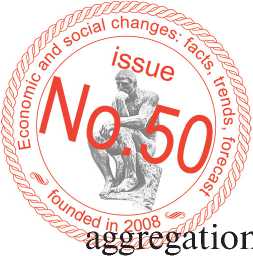
of the expert survey results. The group of experts included specialists from the Department of Culture and Tourism of the Vologda Oblast, representatives of the agencies involved in the development of tours within the region, scientific staff of ISEDT RAS, representatives of higher educational institutions of the Vologda Oblast, who study the current state, trends and prospects of tourism development.
Table 8 contains the results of PEST analysis, which are represented as a ranked series of the most important factors, including political (Policy), economic (Economy), social (Society) and technological (Technology) aspects of the external environment affecting the development of domestic tourism in the Vologda Oblast in the short, medium and long term.
Conclusion . PEST analysis conducted by the author shows that economic and technological factors will have the greatest influence on the development of domestic tourism in the short and long term. In this
Table 8. Ranking of the most important environmental factors influencing the development of domestic tourism in the Vologda Oblast
Major tasks during the implementation of conceptual aspects of development of internal tourism are as follows.
-
1. Development of priority internal tourism product; in this case, it can be done with the use of e-commerce, online booking systems and innovation solutions. This will help increase the competitiveness of the tourist product of the region and to differentiate it among similar products of competitors.
-
2. Promotion of demand for domestic tourism product or service based on the current and future needs of the population and the compliance of this product or service with the requirements of potential consumers.
-
3. Formation of an affordable supply of quality domestic tourist product on the basis of currently available and prospective tourism resources of the region. When implementing this direction, local authorities must carry out the policy aimed to improve the relations with the subjects of the tourism industry, this policy should include the following
Competitive tourist products should be formed should be based on the development of tourism activities that increase the flow of domestic tourists. For example, such types of tourism include event tourism.
It is possible to implement this direction through the use of marketing approach, in particular, target marketing, which involves the development of a specific tourist product for a specific segment of consumers. First, regional tourism administrations need to conduct marketing research on a continuous basis in order to identify consumer preferences of potential tourists and the subs segmentation of the market of domestic tourism services. Second, it is advisable to develop an information campaign to promote tourist resources of the region and people’s desire to travel within the country. Third, in order to improve the quality of services, regional standards of hospitality can be formed, which will enable the region to create the image and reputation of a “hospitable territory” in the eyes of tourists and local population. The creation of such a code can be assigned to scientific or educational organization in the region.
measures:
-
• provision of tax benefits;
-
• provision of guarantees when obtaining loans;
-
• inclusion of travel agencies in regional projects on tourism development.
Thus, the results of this study identify the most effective areas of development of domestic tourism in the region taking into account economic turbulence. These results can be used by regional authorities in developing appropriate programs.
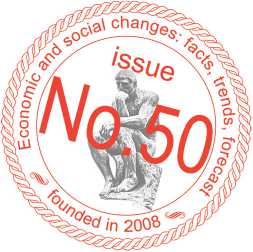
Список литературы Domestic tourism development in a region
- Anchukova N.V., Moskvina O.S. Turizm v ekonomike regiona . Vologda: VNKTs TsEMI RAN, 2002. 72 p..
- Granberg A.G. Osnovy regional'noi ekonomiki: ucheb. dlya vuzov . 5th edition. Moscow: GU VShE, 2006. 495 p..
- Grigorenko T.N., Kaz'mina L.N. Prioritety v oblasti razvitiya vnutrennego i v"ezdnogo turizma Rossii na sovremennom etape . Vestnik natsional'noi akademii turizma , 2015, no. 4, pp. 14-17..
- Kvartal'nov V.A. Turizm: uchebnik . Moscow: Finansy i statistika, 2002. 320 p..
- Kosheleva A.I. Turistsko-rekreatsionnyi kompleks Kryma: problemy i perspektivy razvitiya v perekhodnyi period . Region: ekonomika i sotsiologiya , 2015, no. 3, pp. 239-254..
- Kruzhalin V.I., Kruzhalin K.V., Shabalina N.V. Sostoyanie rossiiskogo turizma, problemy i perspektivy . Vestnik natsional'noi akademii turizma , 2016, no. 1, pp. 10-13..
- Makeeva D.R. Ekonomika turizma Rossii na sovremennom etape: ot vyezdnogo turizma k orientirovannomu na vnutrennii rynok . Voprosy regional'noi ekonomiki , 2015, no. 1, pp. 39-48..
- Ovcharova L.N. (Ed.). Naselenie Rossii v 2016 godu: dokhody, raskhody i sotsial'noe samochuvstvie. Monitoring NIU VShE. Iyul' 2016 . Moscow: NIU VShE, 2016..
- Semenova E.V., Maslova N.V. Problemy razvitiya vnutrennego turizma i nekotorye puti ikh resheniya . Vestnik natsional'noi akademii turizma , 2016, no. 3, pp. 34-36..
- Grinberg R.S., Rubinshtein A.Ya., Abalkin L.I., Glaz'ev S.Yu., Makarov V.L. et al. Strategicheskie orientiry ekonomicheskogo razvitiya Rossii . Saint-Petersburg: Aleteiya, 2010. 664 p..
- Ilyin V.A., Plekhanov Yu.N., Uskova T.V., Selyakova S.A., Dubinicheva L.V., Markov K.V., Bogacheva E.N. Strategiya razvitiya turizma v Vologodskoi oblasti . Vologda: VNKTs TsEMI RAN, 2009. 187 p..
- Tatarkin A.I., Bimatov M.R. Otsenka investitsionnykh potrebnostei sotsial'no-ekonomicheskogo razvitiya regiona . Zhurnal ekonomicheskoi teorii , 2010, no. 2, pp. 29-33..
- Uskova T.V., Dubinicheva L.V., Orlova V.S. Sotsial'no-ekonomicheskii resurs turizma: monografiya . Vologda: ISERT RAN, 2011. 182 p..
- Gulin K.A. K voprosu o sotsial'no-ekonomicheskoi modernizatsii rossiiskikh regionov . Ekonomicheskie i sotsial'nye peremeny: fakty, tendentsii, prognoz , 2012, no. 4 (22), pp. 42-58..
- Lukin E.V., Vorontsova T.V., Smirnova T.G. Problemy ekonomicheskogo rosta territorii: monografiya . Under academic supervision of Uskova T.V. Vologda: In-t sotsial'no-ekonomicheskogo razvitiya territorii RAN, 2013. 170 p..
- Chernikova L.I., Faizova G.R. K voprosu pereorientatsii na vnutrennii turizm . Finansovaya analitika: problemy i resheniya , 2016, pp. 52-60..
- American Express Spending & Saving Tracker. Available at: http://about.americanexpress.com/news/sst
- Economic Impact of Travel & Tourism 2015. Available at: http://www.wttc.org/research/economic-research/economic-impact-analysis
- Falk J. H., Ballantyne R., Packer J., Benckendorff P. Travel and learning: Aneglected tourism research area. Annals of Tourism Research, 2012, no. 39, pp. 908-927.
- International tourism. Available at: http://www.worldbank.org/en/country/russia
- Antonakakis N., Dragouni M., Eeckels B., Filis G. Tourism and economic growth: Does democracy matter? Annals of Tourism Research, 2016, no. 39, pp. 231-267.

